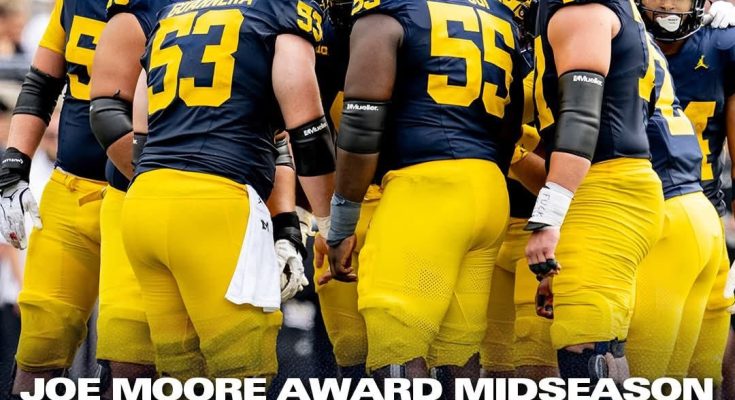The Joe Moore Award is unique among college football honors in that it recognizes not an individual, but a collective — the offensive line unit that exhibits excellence in technique, toughness, consistency, finishing, teamwork, and effort over the course of a season. Since its inception in 2015 by the Foundation for Teamwork, the award has sought to exalt what is often the unsung backbone of potent offenses: the five (or more) men who anchor the line of scrimmage, protect the quarterback, and pave the way for the run game. Midway through each season, the award’s selection committee releases a Midseason Honor Roll, a list of units that through film study and statistical observation have positioned themselves as early contenders for the coveted ultimate prize.
The Midseason Honor Roll is more than a preliminary list of names; it is a snapshot of how the trenches are shaping the race. It is based on weekly film review, often supplemented by cut-ups provided by offensive line coaches. The committee eschews raw box‑score metrics in favor of tape-based evaluation, seeking signs of cohesion, discipline, finishing blocks, physicality at the point of attack, footwork, ability to recover on stunts or blitzes, consistency across downs, and resilience under pressure. These criteria mirror the ethos of Joe Moore, the legendary coach whose name the award bears. The six criteria guiding selection are toughness, effort, teamwork, consistency, technique, and finishing. Units that repeatedly show up, bounce back from adversity, and impose their will on defenses attract the attention of the committee.
A Midseason Honor Roll announcement is more than just recognition; it also sets a tacit expectation. Teams named are presumed to be under a lens: can they maintain or elevate their level under the weight of injuries, tougher opponents, fatigue, and the attrition of a long season? The honor roll is as much a watchlist as a badge of honor. Some units are inevitable appearances — perennial powers or teams with returning starters — but others are surprise inclusions, units exceeding expectations. The public release of the list garners attention to line play, a facet too often overshadowed by glamorous skill‑position statistics.
The compositions of past honor rolls reveal patterns. In 2023, twenty‑three offensive lines earned inclusion: Georgia, Michigan, Ohio State, Texas, Florida State, LSU, Clemson, Oregon, and others, spanning eight conferences plus independents. (Joe Moore Award) In 2024, Clemson’s line (among others) made the list, having helped fuel a 6.14 yards per carry average while allowing five or fewer sacks at that point. (Clemson Tigers Official Athletics Site) That year’s list encompassed 22 units from across major conferences. (Clemson Tigers Official Athletics Site) These lists reflect both power conference hegemony and surprising underdog performances. A unit that may not post gaudy totals but grinds out success against strong fronts — perhaps with fewer penalties, lower TFLs allowed, or superior technique against stunts — can make the cut.
To understand how inclusion works, let’s consider how an emerging unit might capture the committee’s eye. Early in a season, a line might dominate an opponent: imposing physical run blocks, sustained zone drives, consistently handling stunts and blitzes, maxing out in third‑and‑medium or third‑and‑long situations. The unit that repeatedly breeds success for its backfield and quarterback, with few breakdowns, especially late in games, will draw favor. Resilience — for instance, covering for an injured starter or keeping performance stable despite shifting lineups — can elevate a unit in the eyes of voters.
A strong example: in 2025, USC’s offensive line was named to the Midseason Honor Roll. Despite being down multiple starters, the Trojans managed to average 325.8 passing yards per game and 226.5 rushing yards, while the line allowed just three sacks to that point. (USC Athletics) Their versatility (one lineman shifted between guard and tackle spots), depth, and high‑level performance under duress made them a compelling selection. Florida State’s 2025 line also made the list, boasting a top-three total offense and a balanced attack that produced games with over 360 rushing and 360 passing yards. That unit had incurred no sacks in one game and ran for over 230 yards in another. (Florida State University) In both cases, selection rested not merely on cumulative statistics, but on narrative, film-based dominance, consistency, and the visible quality of their play across multiple games.
In addition to seeing stalwart powerhouses, the honor roll often highlights lesser-heralded squads whose line play emerges as a surprise. That is part of its appeal — shining a spotlight on units that might otherwise go unnoticed. The midseason list is often longer than semifinalist or finalist lists, sometimes extending to 19, 22, or 23 teams. In 2021, nineteen units were honored. (Joe Moore Award) In 2022, the list had twenty-two. (Joe Moore Award) In 2020, again twenty-two lines made the cut. (Joe Moore Award) This redundancy ensures depth and provides room for late bloomers.
The committee’s approach generates debate among fans and analysts. Some wonder whether raw metrics — sacks allowed, rushing yards, TFL allowed — should carry more weight; others argue that film vision can expose weakness hidden behind favorable box scores. The balance is delicate: a line may allow fewer sacks because their quarterback releases quickly, or face weaker defensive fronts. The committee tries to calibrate for that by watching technique, body position, reaction time, and consistency across downs. Regardless, inclusion brings validation: coaches advertise it, media outlets highlight it, and player recognition (All‑Conference, All‑American) often follows.
Midseason honor roll status does not guarantee semifinalist or finalist placement, but it often serves as a filtering mechanism: those lines that sustain or elevate performance are likely to advance. It’s common that only a fraction of honor roll units become semifinalists, and fewer still make finalist slots. But being on the list signifies that a unit is in the conversation. It also affords an opportunity for lines to correct course, elevate their play, or make statements late in the season.
Beyond recognition, the midseason roll helps drive accountability. Teams know they are being watched. Line coaches may use that recognition as motivation — “we’re on the list, now let’s stay there, now let’s force inclusion in semifinal round.” For media, it gives structure to discussion about offensive lines — often overlooked — by supplying names, storylines, and benchmarks to watch. Football analysts can track which lines are peaking, which are sagging, and which are adjusting through injuries or tough matchups.
Because the honor roll is film-driven, units that show high-end blocks in game-deciding drives can benefit. A wide zone stretch on third down, a double-team peel and finish on cutback lanes, mirror blocks on twist blitzes, pulling guards finishing blocks — these subtle hallmarks matter. A unit that can show “late in down” finish — pancakes or driving defenders off the line after the whistle — signals tenacity, and that reflects the “finishing” criterion. Units that degrade — lose technique in late quarters, allow negative plays or lenient punch-through — may fall out of favor, even if their cumulative stats remain solid.
Also, cohesion matters. A group that rotates in backups yet holds consistency, or a group that shifts a tackle or guard seamlessly, will be viewed more favorably than a unit that crumbles under pressure or loses structural integrity. The committee wants to see that the whole is greater than the sum of parts. The synergy, communication (picking up stunts or switches), and shared understanding of assignments weigh heavily in evaluation.
In many respects, the midseason roll mirrors midseason watch‑lists for individual awards — it serves to highlight, to foreshadow, but not to finalize. While individuals can accumulate highlight reels or gaudy stats early, line units often reveal progressive narratives: continuity builds momentum, midseason adversity tests depth, and the second half of the season demands durability. Lines that start strong may fade; underdogs may rise; that dynamic arc is part of the intrigue.
Historically, some units that appeared midseason went on to win. Others never made it past semifinal rounds. But the honor roll gives early prestige, recruiting leverage, internal motivation, and audience attention. It also reinforces the idea that the trenches matter — that games are won and lost in the trenches.
One nuance: being omitted does not doom a season — some units fly under the radar early, then smash through in the latter half and still contend. The honor roll is not perfect or predictive, but it’s a meaningful gauge. In any given season, the list reveals which trenches are demanding respect, which programs invest in their line play, which underdogs emerge, and which units compel analysts to adjust their thinking.
Ultimately, the Midseason Honor Roll of the Joe Moore Award casts a spotlight on an often‑obscured segment of the game. It encourages fans, media, and coaches alike to pay attention to the five whose daily battles create windows for running backs, homes for quarterbacks, and the foundation for sustained offense. In a sport enamored with stars and splash plays, the honor roll reminds us: line play is not glamour, but it is everything.


